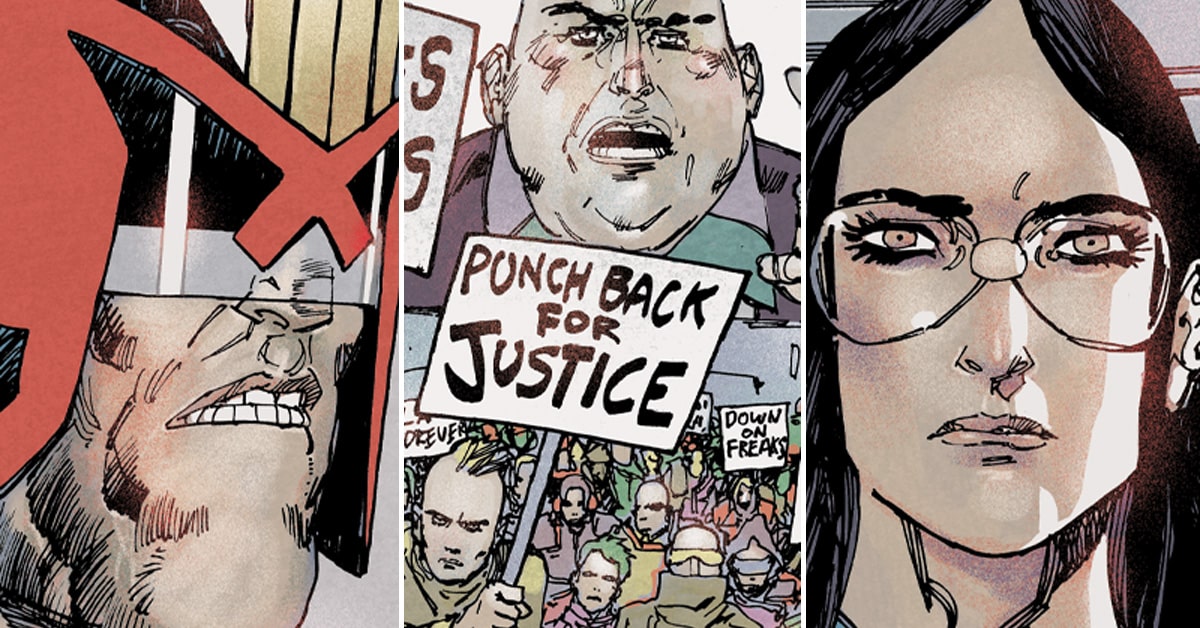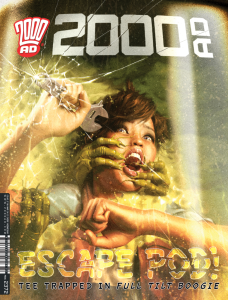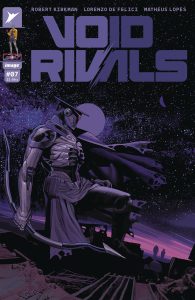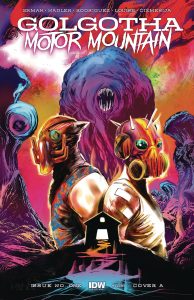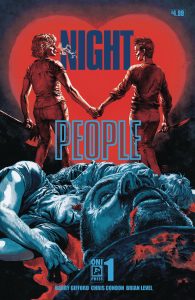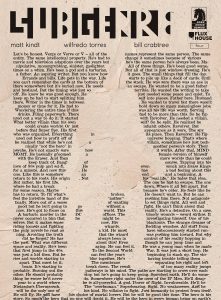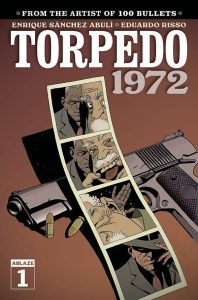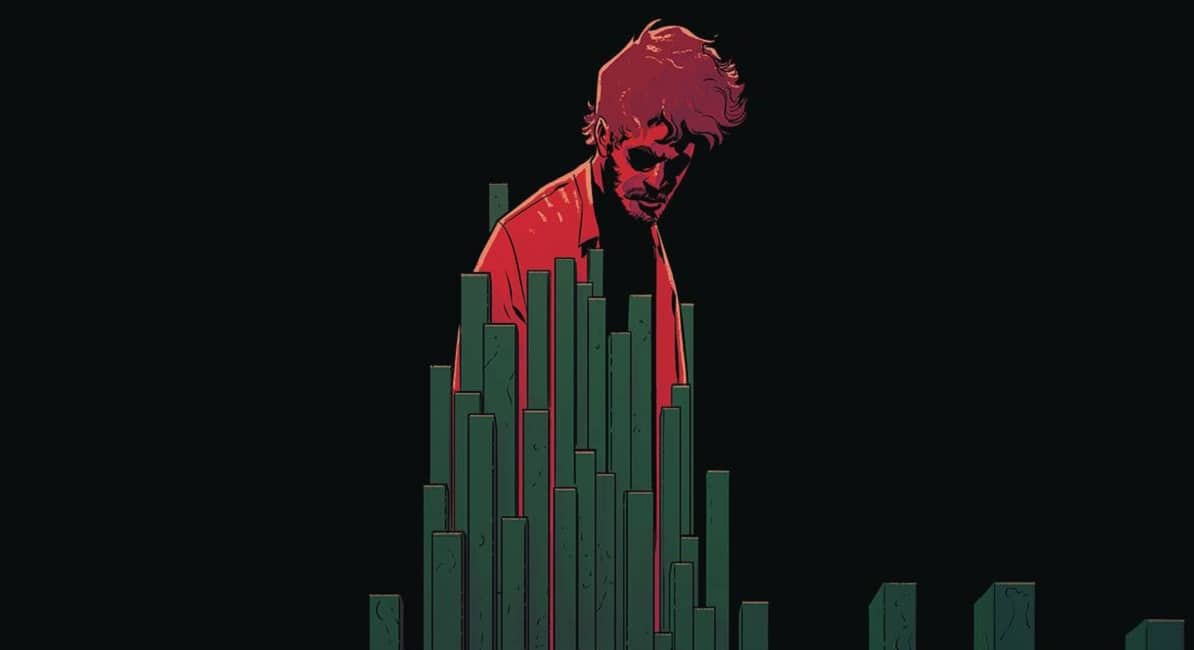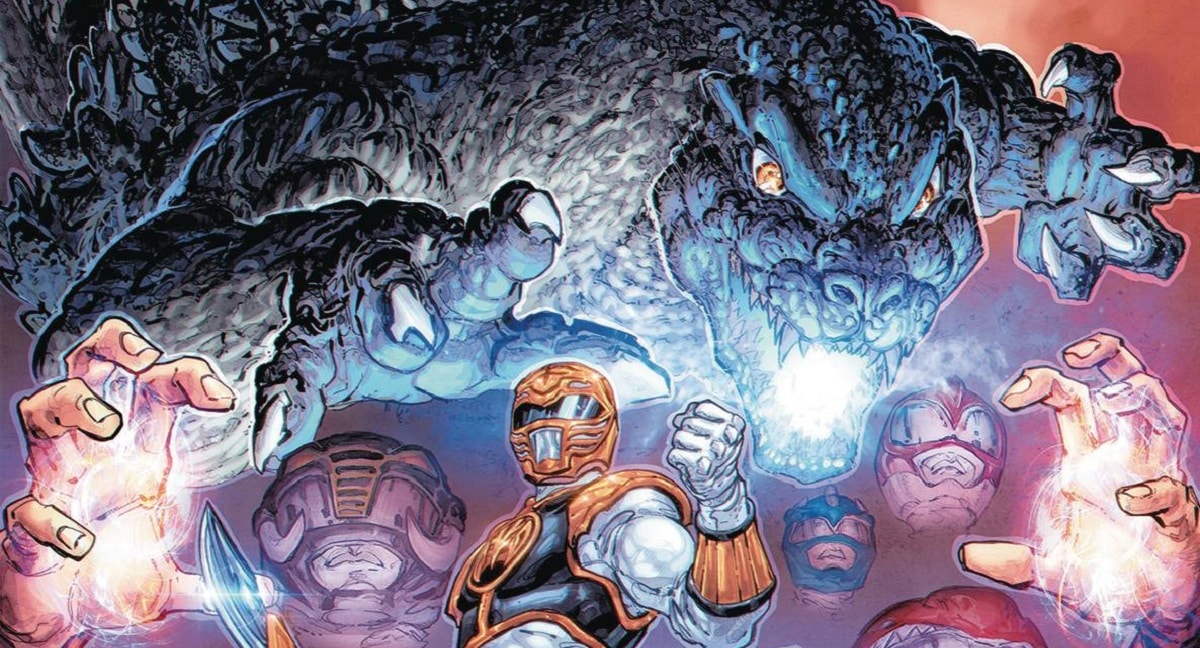This week’s main review is 2000 AD PROG 2372, which wraps up an incredible Judge Dredd story this week. Plus, the Wednesday Comics Team has its usual rundown of the new #1s, finales and other notable issues from non-Big 2 publishers, all of which you can find below … enjoy!
 2000 AD Prog 2372
2000 AD Prog 2372
Writers: Rob Williams and Arthur Wyatt
Artist: Henry Flint
Letterer: Annie Parkhouse
Review by Zack Quaintance
Regular readers of this column are (hopefully) familiar with The Prog Report, a weekly section that follows the comics in 2000 AD’s excellent weekly anthology. Normally, The Prog Report appears at the bottom of the column, and is no longer than a paragraph, maybe two. But this week’s Prog 2372 concludes Judge Dredd: A Better World, which for my money has been the best serialized comic story of 2024 so far. So, it felt fitting to elevate it to the main review.
If you haven’t been following it, A Better World is the culmination of several Judge Dredd stories from writers Rob Williams and Arthur Wyatt. This week is the concluding chapter of a story that has followed Judge Maitland’s efforts to implement police reform in one sector of Mega City One, investing in education and community outreach instead of militarizing the judges. Throughout A Better World, Maitland’s efforts have shown progress statistically, while also being met with pushback from an array of powerful adversaries, ranging from other judges to sensationalist fear-mongering media personalities.
It seems a bit obvious to point out, but one of the main things that has elevated this story to the upper echelons of 2024 comics is the artwork by Henry Flint. Flint’s work here is just stunning at every turn, with a style that is certainly all his own, but also might have you thinking of Moebius more than a few times. His de facto page layout for A Better World is, in a word, claustrophobic. Densely paneling his pages and giving the entire affair a sort of pressure cooker feel, an ominous sense of unavoidable disaster building.
It’s a perfect way to approach a story about doing the right thing, being smart and caring, being right, and suffering for it because there are so many deeply-entrenched actors that benefit from societal inertia, or — in a more kind reading — simply can’t see past doing things the way they’ve always been done. Flint also knows here exactly where to trade the dense paneling for moments of great impact. I won’t spoil it here because I suspect many readers of this column will pick up this book in trade, but this story has some moments in it that physically dropped my jaw, as if I were a cartoon.
This week’s concluding chapter is as somber as it is inevitable. It is a tragic one but of course it was always going to be. What I found most interesting though, is in light of all that happened, there’s just a slight bit of optimism to this conclusion. Look, it’s not a lot, and it’s definitely not a happy ending. But there’s something subtle here that suggests that all of this will matter. Maybe I’m looking for hope where it isn’t, but I think it’s a true credit to the thoughtfulness of this story that the final note doesn’t feel entirely cynical to me, that I had a faint sense that even the most difficult setbacks can move forward the long arc of history if someone (anyone) takes notice. That said, the last page hit me like a brick to the face.
So yes, I highly recommend checking out the Prog 2372, but only if you’ve read the entire Judge Dredd: A Better World arc, which starts in Prog 2364, and is available now online here, specifically via the A Better World digital bundle.
 Void Rivals #7
Void Rivals #7
Writer: Robert Kirkman
Arist: Lorenzo De Felici
Colorist: Patricio Delpeche
Letterer: Rus Wooton
Publisher: Image Comics
Review by Jordan Jennings
Void Rivals returns from a brief hiatus this week with Void Rivals #7. For those that are unfamiliar with Void Rivals, it was the first comic to come from Skybound Entertainment’s Energon Universe comics. Back in June 2023, the series made a big splash by being the stealth debut of the Transformers (and technically GI Joe) at Skybound following the license departing IDW at the end of 2022.
As a series, Void Rivals focuses primarily on Darak and Solila, pilots from two warring civilizations: Agorria and Zertonia, respectively. Each civilization lives on opposing sides of a The Sacred Ring, a colossal megastructure that surrounds a dying star. After both pilots crash their ships into the surface of a comet, they quickly learn that they are one people and that the governments are keeping their people against each other through propaganda. For what purpose? We, the readers, are not entirely sure yet and serves as the mystery of the series. Whatever the reason, it is enough for the Zertonians to want Darak and Solila dead.
As the first arc concluded, we saw Darak and Solila attempt to flee Zertonia via the Wasetland, a large gap on The Sacred Ring that separate the two civilizations. Void Rivals #7 picks up right where we left our protagonists and we are introduced to the only person that the Zaliak, the Zertonian leader, entrusts in killing the Rivals—Proximus.
Void Rivals #7 is, for better and for worse, very much a Robert Kirkman comic. The single issue is extremely light on plot development but instead focuses on character work. This works to Kirkman’s strength as he has a knack for sharp dialog and knows how to navigate complex interpersonal dynamics between the cast. The mystery behind Darak’s past is compounded in the issue which feels like set up, but it does create an interesting dynamic between Darak and Solila. Their story is very much about trust as they attempt to overcome past conditioning of hating the other side.
This is in contrast to the relationship Kirkman sets up between the antagonist of the arc, Zaliak and Proximus. Kirkman does a satisfying job giving the sense of history between the two but not explicitly stating what happened. Either way, there is a lot of shared animosity between the antagonist, and it is compelling to read.
The big fault I have with this issue is one I have with a lot of Kirkman comics—they are popcorn fare. They are enjoyable and quick experiences but leave you walking away feeling empty. This issue does not feel like a complete story but instead a chapter in the overall story. This ultimately comes down to personal taste and philosophy regarding the single-issue format. If you are looking for a single-issue experience that has a full plot structure, you would be better served looking elsewhere. If you don’t mind comics being a larger piece of the puzzle, you will find a solid read. Personally, I find Kirkman’s work reads better in trade. That doesn’t mean Void Rivals is a bad comic. On the contrary, it is well constructed and enjoyable. Ultimately, I prefer a comic that has a basic plot arc within the issue. It is more satisfying experience for me.
What I find to be the main appeal of Void Rivals is the sci-fi aesthetic crafted by the artist Lorenzo De Felici. The design of this world is just visually interesting in ways that few comics manage to be. The suits that each of the main characters capture the vibe that this comic belongs in the same universe as Transformers. On top of that, the character designs are simultaneously visually distinct from each other yet all within the same consistent design philosophy to speak about the broken unity theme of the series.
De Felici’s art is extremely kinetic, from the character’s body language to the page layouts. Sometimes this is to a fault and there are panels where it can be hard to follow what is exactly happening but the rush as your eyes moves from panel to panel, page to page, compensates for that some. De Felici use of double page spreads in this issue is noticeably more than in the past, but they help magnify the size and scale of the universe. It also helps act as breathers between major action scenes.
Additionally, there is this one set of two pages have a stark visual contrast between virtual reality and reality itself and highlight the dynamic between the antagonists. Patricio Delpeche’s colors really help set the emotion of these pages and the issue.
Void Rivals #7 is an enjoyable start to a new arc. While it may leave you wanting more, it is well constructed, and a captivating read. The series continues to be a decent sci-if comic that plays in familiar territory of other sci-fi properties but finds a novel way to explore that territory. I recommend this issue, but you may find it better to wait for the trade.
Wednesday Comics Reviews
Golgotha Motor Mountain #1 (IDW Publishing): Splatterpunk is such a difficult genre to translate into the comic medium. Without the practical effects and squishy sounds, you’re left with blood as the only texture to convey the visceral, breakneck speed of splatterpunk. But I’m not about to come down here and tell you this book failed in its gorey endeavours. With a cast of B-movie outcasts each a bigger dirtbag than the last, writers Matthew Erman and Lonnie Nadler have built a brick shithouse to splat their way through. A mysterious meteor, neo-nazis that get summarily dealt with, and meth dealing brothers cosplaying dirtbag Kamen Rider— the land is primed for conflict up on Golgotha Motor Mountain. Not for nothin’, adding disgraced artist Robbi Rodriguez to the mix feels truer to the splatterpunk genre than hiding from it [and his] controversial past. The real standout here is colorist Marissa Louise’s approach to depicting an ashy backwood colony full up on dirt, but not so much soap. Beneath a mixture of tree stamps, noisy ink splatter, digital inkwash, and halftone lies an earthy green closer to yellow than normal, which results in an atmosphere betwixt puke and nature that feels at home in Golgotha Motor Mountain. Add redacted caption boxes that Hassan Otsmane-Elhaou fills with faux-historical tidbits and “Kentucky manga” excerpts by Nikola Čižmešija, and the book starts to feel like something we shouldn’t be reading. This too feels like a tenet of splatterpunk. So, if you’re looking for something you shouldn’t be reading, maybe check out that there Golgotha Motor Mountain. —Beau Q.
Night People #1 (Oni Press): A new religious movement brings about a misandry-motivated murder spree and the effects are chilling as is the art by Brian Level. Level brings a great sense of heavy blacks and textures to dial up the mood here, paired with strong character design where every smile feels full of ill-intent and the blood and gore are drawn in vivid detail. This is only played up by the color work of Ronda Pattinson, who pushes the mood of each scene, be it through green skies communicating a sense of southern humidity or playing with reds when the story leaves a scene of carnage. There’s a lot of carnage and we get our first dose of it in the first two pages when we along with two cops are met with two decapitated corpses, it’s brutal. The lettering of Shawn Lee meshes perfectly with the art, bringing a similar line quality to Level’s that plays well off of the art as well as weaving it seamlessly into it. The letters also hit subtleties that are wonderful to observe, really making this a graphic yet stunning book to read. Written by Chris Condon, Night People adapts the novel of the same name by author Barry Gifford. Condon has crafted a strong first issue, really allowing readers to get acquainted with the kind of characters we’ll be journeying with and the depravity they’re engaged in. It’s an exploration of religious fanaticism and interestingly through the characters Bet and Cutie, who we spend the most time with, a sort of queering of religious norms that made me go “hm, neat” before they took their faith to a murderous degree. It certainly tracks for the bible belt and sadly doesn’t feel that far-fetched, but maybe that’s the point as Gifford and now Condon, through this adaptation, explore the southern subconscious. —Khalid Johnson
Subgenre #4 (Dark Horse Comics): Subgenre concludes as our protagonist, Vee, confronts his past but in the fashion of narcissism, can’t hold himself accountable for how he ended up where he is. Subgenre serves as an excellent character study of someone who is deeply flawed and further still, a fun exploration of the comics medium as simply adding a texture to Bill Crabtree’s colors shifts the entire feel of Wilfredo Torres’ art, creating a sort of pulp style that just feels like such a perfect extension of Torres’ work, before we’re transported back to the polish of a futuristic setting. Letterer Jim Campbell pulls the art together, weaving narration and balloons seamlessly through the art and pages. This conclusion looks at how we engage with stories and further still, serves as a running critique of escapism and what that actually means when we’re confronted with the problems of the world or our own personal problems. Through this, writer Matt Kindt continues the critique of Ai taking it to an interesting conclusion on the last page of the story, one that feels rather fit for Vee considering who Kindt reveals him to be and the limits of escapism when we’re simply looking for an easy way out. It’s really thought-provoking, and a fitting conclusion. —Khalid Johnson
Torpedo 1972 #1 (Ablaze Publishing): Trigger warning for sexual assault. For years, I’ve had a 100 Bullets reread on my To-Do, but haven’t gotten around to it. You’d think Torpedo 1972 would suffice, but it really only retreads the worst content 100 Bullets has to offer. Sure, Eduardo Risso still tells unspoken stories in the foreground/background planes, and readability is never a chore with eyelines this efficient. But the writing by Enrique Sánchez Abulí and Risso’s shot selection go out of their way to frame the female lead as a “she had it coming” case I cannot abide. While the creators are keen to bring some 70s poliziotteschi to modern day comics, the trademark violence is welcome, but the overbearing misogyny so thick you’ll remember what a locker room smells like– not so much. Crime fiction has evolved past the need to debase its female protags in order to communicate how big a piece of shit the villain will be. Skip this. —Beau Q.
Read more entries in the weekly Wednesday Comics reviews series!


